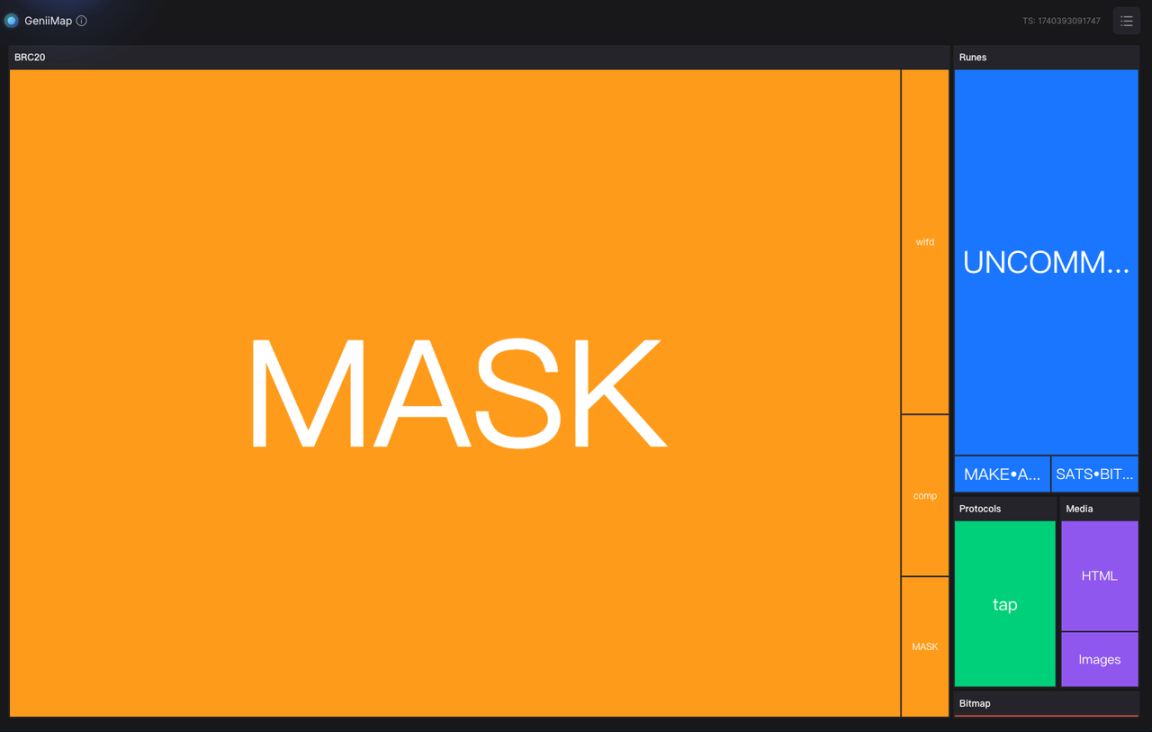Will the pursuit of absolute fairness backfire stability?
Author: ChandlerZ, Foresight News
On February 24, the Gas fee on the Bitcoin chain rose significantly after a long period of low operation, climbing from the previous average of 1-2 Cong/byte to a high priority of more than 12 Cong/byte. A few weeks ago, the Bitcoin memory pool was completely emptied for the first time in nearly two years, but the number of unconfirmed transactions has climbed again to more than 100,000.
According to Genidata data monitoring, in the past 24 hours, on-chain casting activities have shown a high degree of concentration, mainly focusing on the MASK project.

The total number of MASK castings is 2.1 million, each containing 10 tokens. The current market price remains at around US$0.18, and the total market value is approximately US$3.06 million. As of the latest data, the project’s casting progress has reached 82.69%. This increase in activity has triggered widespread discussions in the market that the BRC-20 ecosystem may usher in a new round of recovery.
Judging from the deep logic of the market, the current encryption market is at a special time point. At a time when the cabal theories of Solana Ecology and BSC Ecology are widely questioned, the BRC20, which symbolizes “fairness” to some extent, seems to have regained market attention. However, the memory of the market has not faded over time, and the previous violent fluctuations in the Bitcoin ecosystem still leave a shadow on the market.
Watching him build a tall building, watching his building collapse
According to The Block data, since April 20, 2023, driven by the BRC-20 ecosystem, the number of transactions on the BTC network has begun to rise sharply, and the transaction volume has increased nearly doubled in less than a month. The rise in transaction fees was even steeper, rising nearly 10 times in less than half a month. At the most active stage of the BRC-20 ecosystem, more than 70% of transactions on the Bitcoin chain were related to BRC-20 projects.
Behind this appearance of prosperity lies a fragile ecological foundation. After entering 2024, the Bitcoin ecosystem has gradually fallen into a downturn. This change actually reflects the market’s deep dilemma for the Bitcoin application layer. Although the market had high hopes for the Bitcoin ecosystem and believed that innovation based on the inscription protocol could inject new vitality into the Bitcoin network, the actual development trajectory has greatly deviated from expectations.
Looking back at the development history of the BRC20 ecosystem, we have to face a cruel reality. Most of the early popular projects experienced extremely significant price retracements. ORDI fell from a high of US$87 to US$11, Sats fell from 0.00000086 to 0.0000012. It can even be said that most of the NFT of other projects and even the Bitcoin ecosystem have dropped by as much as 90%, which has long been “zeroed”, and only projects with a serious local promotion culture such as are remaining.
This phenomenon is not accidental, but an external manifestation of deep-seated market structural problems. The BRC20 agreement has “true fairness” as its core concept at the beginning of its design. It attempts to provide all market participants with truly equal opportunities to participate through a completely transparent on-chain mechanism and eliminate reservations and scientist mechanisms. This design does achieve the greatest degree of decentralization in theory, but it exposes significant limitations in practice.
The paradox of fairness and control
From the perspective of market structure, the scientist mechanism and initial chip allocation system in traditional encryption projects are essentially a market regulation tool. Although these mechanisms are often criticized as manifestations of centralization, they play an indispensable role in maintaining market stability. Through these mechanisms, the project party can regulate market fluctuations to a certain extent and provide necessary price support for the long-term development of the project.
However, the completely open casting mechanism of the BRC20 ecosystem, while maximizing the fairness of participation, also leads to a high degree of dispersion in the chip structure. In the absence of effective price support mechanisms, market fluctuations tend to be more intense. In this case, when market sentiment changes, a chain reaction is easy to occur, leading to a rapid decline in prices.
The deeper problem lies in the motivation for big money to participate. In traditional encryption projects, large funds can influence market trends through various mechanisms to gain benefits. However, under the inscription mechanism of the BRC20, this operating space is greatly compressed. When these so-called “bookmakers” or “institutions” find it difficult to establish effective chip control, they will naturally choose to move to other markets where money management is easier. This creates a paradox: the pursuit of absolute fairness may lead to market instability and thus harm the interests of all participants. In this case, the market needs to find a balance between complete fairness and the necessary market stability.
The resurgence of the MASK project shows to some extent that the market’s yearning for a fair mechanism has not completely subsided, regardless of whether the project is still a “meteor”. However, how to establish an effective market stability mechanism while maintaining basic fairness remains the core challenge facing the entire encryption ecosystem. This requires innovation at the protocol design level and may require the introduction of new mechanisms to balance the seemingly contradictory goals of decentralization and market stability.



